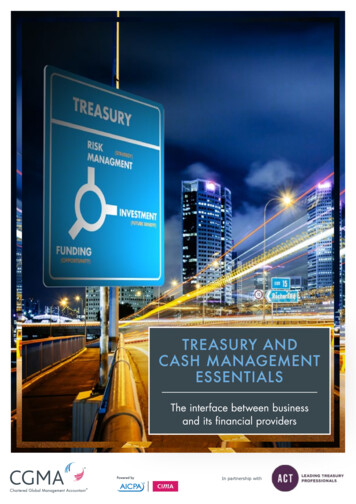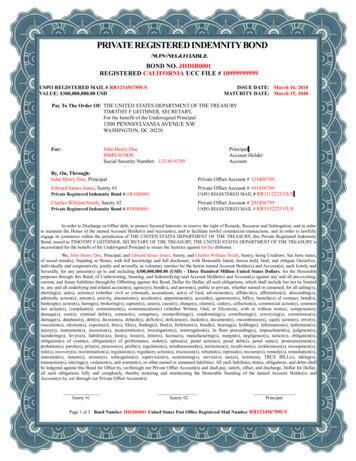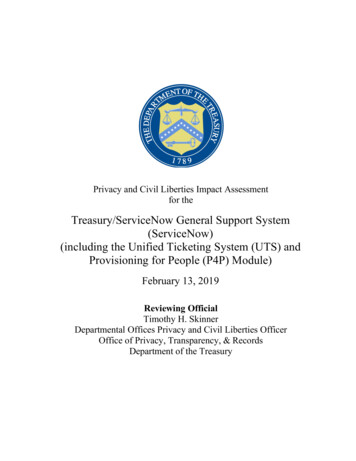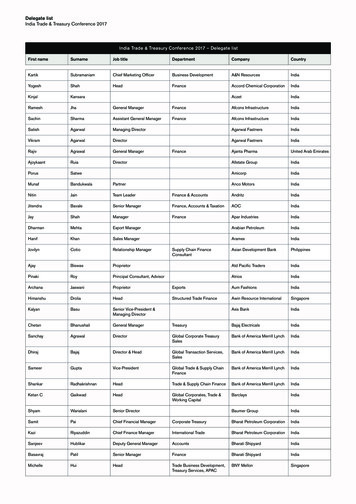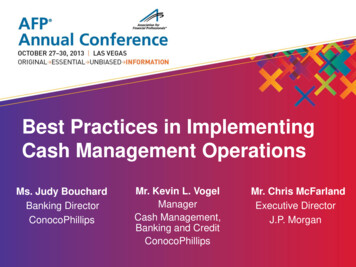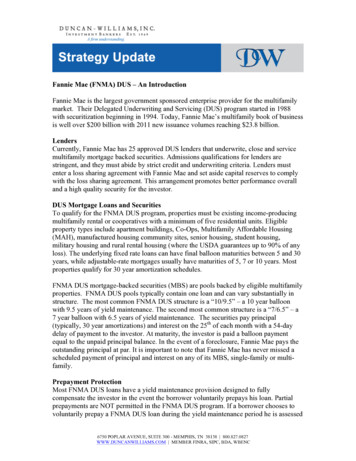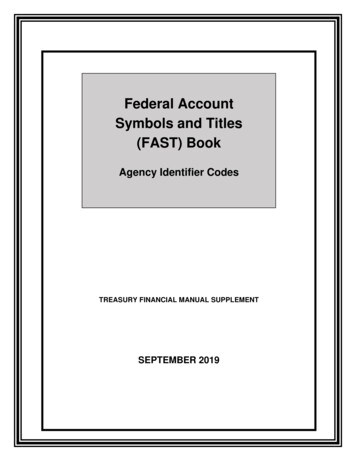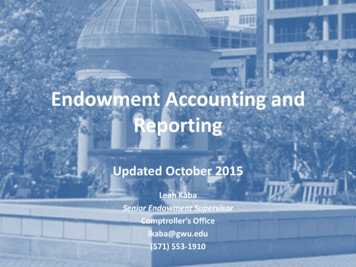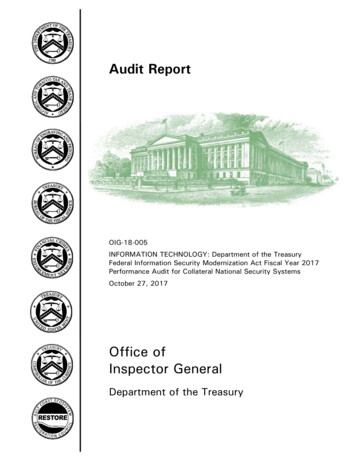
Transcription
Audit ReportOIG-18-005INFORMATION TECHNOLOGY: Department of the TreasuryFederal Information Security Modernization Act Fiscal Year 2017Performance Audit for Collateral National Security SystemsOctober 27, 2017Office ofInspector GeneralDepartment of the Treasury
THIS PAGE INTENTIONALLY LEFT BLANK
DEPARTMENT OF THE TREASURYW ASHINGTON, D.C. 20220OFFICE OFINSPECTOR GENERALOctober 27, 2017MEMORANDUM FOR KODY KINSLEYASSISTANT SECRETARY FOR MANAGEMENTERIC OLSONACTING DEPUTY ASSISTANT SECRETARY FORINFORMATION SYSTEMS AND CHIEF INFORMATIONOFFICERFROM:Larissa Klimpel /s/Director, Cyber/Information Technology AuditSUBJECT:Audit Report – Department of the Treasury FederalInformation Security Modernization Act Fiscal Year 2017Performance Audit for the Collateral National SecuritySystemsWe are pleased to transmit the attached report, Department of the Treasury FederalInformation Security Modernization Act Fiscal Year 2017 Performance Audit for theCollateral National Security Systems, dated October 26, 2017. The FederalInformation Security Modernization Act of 2014 (FISMA) requires that Federalagencies have an annual independent evaluation performed of their informationsecurity programs and practices to determine the effectiveness of such programsand practices, and to report the results to the Office of Management and Budget(OMB). OMB delegated its responsibility to the Department of Homeland Security(DHS) for the collection of annual FISMA responses. FISMA also requires that theagency Inspector General (IG) or an independent external auditor perform theannual evaluation as determined by the IG.To meet our FISMA requirements, we contracted with KPMG LLP (KPMG), acertified independent public accounting firm, to perform this year’s annual FISMAaudit of Treasury’s collateral national security systems. In connection with ourcontract with KPMG, we reviewed its report and related documentation andinquired of its representatives. Our review, as differentiated from an auditperformed in accordance with generally accepted auditing standards, was notintended to enable us to conclude on the effectiveness of Treasury’s informationsecurity program or its compliance with FISMA. KPMG is responsible for its reportand the conclusions expressed therein.
Page 2In brief, KPMG reported that consistent with applicable FISMA requirements, OMBand the Committee on National Security Systems policy and guidance, and theNational Institute of Standards and Technology standards and guidelines, Treasuryestablished and maintained information security programs and practices for itscollateral national security systems for the 5 Cybersecurity Functions and 7 FISMAprogram areas. However, KPMG identified 4 deficiencies within 2 of the 5Cybersecurity Functions and within 4 of the 7 FISMA program areas. Accordingly,KPMG made 7 recommendations to address these deficiencies.Appendix III of the attached KPMG report includes The Department of theTreasury’s Consolidated Response to DHS’s FISMA 2017 Questions for InspectorsGeneral.If you have any questions or require further information, you may contact me at(202) 927-0361.Attachment
Department of the TreasuryFederal Information Security Modernization ActFiscal Year 2017 Performance Audit for theCollateral National Security SystemsOctober 26, 2017KPMG LLP1676 International Drive, Suite 1200McLean, VA 22102
Department of the TreasuryFederal Information Security Modernization Act Fiscal Year 2017 PerformanceAudit for the Collateral National Security SystemsTable of ContentsFISMA Performance Audit ReportBACKGROUND . 5Federal Information Security Modernization Act of 2014 (FISMA) . 5FY 2017 Inspector General FISMA Reporting Metrics . 5Federal Standards and Guidelines . 6Department of the Treasury Information Security Management Program . 7OVERALL PERFORMANCE AUDIT RESULTS . 9FINDINGS.101. The Treasury Directive Publication (TD P) 85-01, Department of the TreasuryInformation Technology Security Policy, Appendix B, “Classified (National SecuritySystems),”and Departmental Offices (DO) Collateral National Security System(NSS) System Security Plan (SSP) were not updated in accordance withCommittee on National Security Systems (CNSS) No. 1253, SecurityCategorization and Controls Selection for National Security Systems, guidance. .102. DO Collateral NSS patch management process was not compliant with theTreasury Information Technology Security Policy. .113. DO collateral NSS account management activities were not compliant with its SSPpolicies. .124. DO did not perform Business Impact Analyses (BIAs) for the DO Collateral NSS. .13SELF-IDENTIFIED WEAKNESSES .15MANAGEMENT RESPONSE TO THE REPORT .16AppendicesAPPENDIX I – OBJECTIVE, SCOPE AND METHODOLOGY .21APPENDIX II – STATUS OF PRIOR-YEAR FINDINGS .25APPENDIX III – DEPARTMENT OF THE TREASURY’S CONSOLIDATED RESPONSE TODHS’ FISMA 2017 QUESTIONS FOR INSPECTORS GENERAL .29APPENDIX IV – GLOSSARY OF TERMS .59
KPMG LLP1676 International DriveMcLean, VA 22102The Honorable Eric ThorsonInspector General, Department of the Treasury1500 Pennsylvania Avenue, NWRoom 4436Washington, DC 20220Re: Department of the Treasury’s Federal Information Security Modernization Act FiscalYear 2017 Performance Audit for Collateral National Security SystemsDear Mr. Thorson:This report presents the results of our independent performance audit of the Department of theTreasury’s (Treasury or Department) Collateral National Security Systems (NSS) informationsystems’ security program and practices. The Federal Information Security Modernization Act of2014 (FISMA) requires Federal agencies, including Treasury, to have an annual independentevaluation performed of their information security programs and practices to determine theeffectiveness of such programs and practices, and to report the results of the evaluations to theOffice of Management and Budget (OMB). OMB delegated its responsibility to Department ofHomeland Security (DHS) for the collection of annual FISMA responses. DHS prepared theFISMA questionnaire to collect these responses, which is provided in Appendix III, Departmentof the Treasury’s Consolidated Response to DHS’s FISMA 2017 Questions for InspectorsGeneral, dated April 17, 2017. We also considered applicable OMB policy and guidelines, theCommittee on National Security Systems (CNSS) policy and guidelines, and the NationalInstitute of Standards and Technology (NIST) standards and guidelines. FISMA requires thatthe agency Inspector General (IG) or an independent external auditor, as determined by the IG,perform the annual evaluation. The Treasury Office of Inspector General (OIG) contracted withKPMG LLP (KPMG) to conduct an audit of Treasury’s information system security program andpractices for its collateral NSS.We conducted this performance audit in accordance with Generally Accepted GovernmentAuditing Standards (GAGAS). Those standards require that we plan and perform the audit toobtain sufficient, appropriate evidence to provide a reasonable basis for our findings andconclusions based on our audit objectives. We believe that the evidence obtained provides areasonable basis for our findings and conclusions based on our audit objectives. We alsofollowed the American Institute of Certified Public Accountants (AICPA) standards applicable toperformance audits.The objective of this performance audit was to assess the effectiveness of the Department ofthe Treasury’s (Treasury) information security program and practices for its collateral NSS forthe period July 1, 2016 through June 30, 2017. As part of our audit, we responded to the DHSFISMA 2017 Questions for Inspectors General, dated April 17, 2017, and assessed the maturitylevels on behalf of the Treasury Office of Inspector General. Additional details regarding thescope of our independent audit are included in Appendix I, Objectives, Scope and Methodology.Appendix II, Status of Prior-Year Findings, summarizes Treasury’s progress in addressing prioryear recommendations. Appendix III includes the Treasury’s Consolidated Response DHS’FISMA 2017 Questions for Inspectors General, and Appendix IV contains a glossary of termsused in this report.KPMG LLP is a Delaware limited liability partnership and the U.S. memberfirm of the KPMG network of independent member firms affiliated withKPMG International Cooperative (“KPMG International”), a Swiss entity.Page 3
Consistent with applicable FISMA requirements, OMB and CNSS policy and guidelines, andNIST standards and guidelines, Treasury has established and maintained its informationsecurity program and practices for its collateral NSS for the 5 Cybersecurity Functions1 and 7FISMA Metric Domains.2 However, the program was not fully effective as reflected in the 4deficiencies within 3 of the 5 Cybersecurity Functions and within 4 of the 7 FISMA programareas that we identified as follows:Cybersecurity Function: Identify:1. The Treasury Directive Publication (TD P) 85-01, Department of the Treasury InformationTechnology Security Policy, Appendix B, “Classified (National Security Systems)” andDepartmental Offices (DO) Collateral NSS System Security Plan (SSP) were not updatedin accordance with CNSS No. 1253, Security Categorization and Control Selection forNational Security Systems, guidance. (Risk Management)Cybersecurity Function: Protect2. DO Collateral NSS patch management process was not compliant with the TreasuryInformation Technology Security policy. (Configuration Management)3. DO Collateral NSS account management activities were not compliant with its SSPpolicies. (Identity and Access Management)Cybersecurity Function: Recover4. DO did not perform Business Impact Analyses (BIAs) for the DO Collateral NSS.(Contingency Planning)We made 7 recommendations related to these control deficiencies that, if effectively addressedby management, should strengthen respective bureau’s, office’s, and Treasury’s informationsecurity program. In a written response, the Acting Deputy Assistant Secretary for InformationSystems and Chief Information Officer (CIO) agreed with our findings and recommendationsand provided planned corrective actions that were responsive to the intent of ourrecommendations (see Management Response).We caution that projecting the results of our evaluation to future periods is subject to the riskthat controls may become inadequate because of changes in technology or becausecompliance with controls may deteriorate.Sincerely,October 26, 20171OMB, DHS, and the Council of the Inspectors General on Integrity and Efficiency (CIGIE) developed the Fiscal Year(FY) 2017 IG FISMA Reporting Metrics in consultation with the Federal Chief Information Officers (CIO) Council. InFY 2017 the seven IG FISMA Metric Domains were aligned with the five functions of identify, protect, detect, respond,and recover as defined in the NIST Framework for Improving Critical Infrastructure Cybersecurity.2 As described in the DHS’ FY 2017 Inspector General Federal Information Security Modernization Act of 2014Reporting Metrics Version 1.0, the 7 FISMA Metric Domains are: risk management, configuration management,identity and access management, security training, information security continuous monitoring, incident response,and contingency planning. Contractor systems metrics were consolidated into the risk management FISMA metricdomain.Page 4
Department of the Treasury FISMA Fiscal Year 2017 Performance Audit for the CollateralNational Security SystemsBACKGROUNDFederal Information Security Modernization Act of 2014 (FISMA)Federal Information Security Modernization Act of 2014, commonly referred to as FISMA,focuses on improving oversight of federal information security programs and facilitating progressin correcting agency information security weaknesses. FISMA requires Federal agencies todevelop, document, and implement an agency-wide information security program that providessecurity for the information and information systems that support the operations and assets ofthe agency, including those provided or managed by another agency, contractor, or othersource. The act assigns specific responsibilities to agency heads and Inspectors General (IGs)in complying with requirements of FISMA. The act is supported by the Office of Managementand Budget (OMB), Department of Homeland Security (DHS), agency security policy, and riskbased standards and guidelines published by National Institute of Standards and Technology(NIST) related to information security practices.FISMA defines a National Security System (NSS) as any information system used or operatedby an agency or by a contractor of an agency where the function, operation, or use of thatsystem (1) involves intelligence activities, (2) involves cryptological activities related to nationalsecurity, (3) involves command and control of military forces, (4) involves equipment that is anintegral part of a weapon or weapon system, or (5) is critical to the direct fulfillment of military orintelligence missions. This report contains the evaluation of the Treasury’s information securityprogram and practices for its collateral NSS, which are NSS that do not deal with intelligence.The audit of the Treasury’s intelligence NSS will be reported separately by the Treasury Officeof Inspector General (OIG).FY 2017 Inspector General FISMA Reporting MetricsFor Fiscal Year (FY) 2017, OMB, DHS, and the Council of the Inspectors General on Integrityand Efficiency (CIGIE) implemented changes to the IG FISMA Reporting Metrics to organizethem around the five information security functions outlined in the NIST Framework forImproving Critical Infrastructure Cybersecurity (Cybersecurity Framework): Identify, Protect,Detect, Respond, and Recover. In addition, CIGIE implemented maturity models for RiskManagement (RM), Configuration Management (CM), Identity and Access Management (IA),Security Training (ST), and Contingency Planning (CP), which are similar to the InformationSecurity Continuous Monitoring (ISCM) and Incident Response (IR) maturity models that wereinstituted in FY 2015 and FY 2016, respectively. Table 1 shows the alignment between theCybersecurity Framework and the FISMA Metric Domains.Page 5
Department of the Treasury FISMA Fiscal Year 2017 Performance Audit for the CollateralNational Security SystemsCybersecurity FrameworkSecurity FunctionsIdentifyProtectDetectRespondRecoverFY 2017 IG FISMA Metric DomainsRisk Management3Configuration ManagementIdentity and Access ManagementSecurity TrainingInformation Security Continuous MonitoringIncident ResponseContingency PlanningIn the past, the ISCM and IR models had maturity levels for people, process, and technology. InFY 2017, CIGIE eliminated specific people, process, and technology elements and instead,issued specific questions. These models have five levels: ad-hoc, defined, consistentlyimplemented, managed and measurable, and optimized. The introduction of the 5-level maturitymodel is a deviation from previous DHS guidance over the CyberScope questions. As such, ayear-to-year comparison of FISMA compliance may not be feasible due to the fundamentalchange in how CyberScope is scored and evaluated.Federal Standards and GuidelinesExcept for systems that meet FISMA’s definition of NSS, the Secretary of Commerce isresponsible for prescribing standards and guidelines pertaining to federal information systemsbased on standards and guidelines developed by NIST. The Committee on National SecuritySystems (CNSS), and Federal agencies that operate systems falling within the definition ofNSS, provide security standards and guidance for NSS. CNSS Instruction No. 1253, SecurityCategorization and Control Selection for National Security Systems, states that the controlsdescribed in NIST Special Publication (SP) 800-53, Revision (Rev.) 4, April 2013, Security andPrivacy Controls for Federal Information Systems and Organizations, shall apply to all NSS. Inaddition, FISMA requires that NIST provide information security controls guidance for systemsidentified as NSS. Treasury used NIST SP 800-59, Guideline for Identifying an InformationSystem as a National Security System (August 2003), to identify its two collateral systems.Treasury is responsible for implementing policies, procedures, and control techniques for itscollateral NSS based on guidance from CNSS. Treasury Directive Publication (TD P) 85-01,Department of the Treasury Information Technology Security Policy, Appendix B, “Classified(National Security Systems),” provides Treasury security policy and standards for all systemsthat process or communicate classified national security information.We reviewed both of the collateral NSS; one managed by the Departmental Offices (DO) andone managed by the Bureau of Engraving and Printing (BEP).3FY 2017 Inspector General Federal Information Security Modernization Act of 2014 Reporting Metrics V.1.0, April17, 2017. In 2017, Contractor Systems was included as part of the Risk Management FISMA metric domainPage 6
Department of the Treasury FISMA Fiscal Year 2017 Performance Audit for the CollateralNational Security SystemsDepartment of the Treasury Information Security Management ProgramTreasury Office of the Chief Information OfficerThe Treasury Chief Information Officer (CIO) is responsible for providing Treasury-wideleadership and direction for all areas of information and technology management, as well as theoversight of a number of IT programs. Among these programs is Cyber Security, which hasresponsibility for the implementation and management of Treasury-wide IT security programsand practices. Through its mission, the Office of the Chief Information Officer (OCIO) CyberSecurity Program develops and implements IT security policies and provides policy complianceoversight for both unclassified and classified systems managed by each of Treasury’s bureaus.The OCIO Cyber Security Program’s mission focuses on the following areas:1. Cyber Security Policy – Manages and coordinates Treasury’s cyber security policy forsensitive (unclassified) systems throughout Treasury, assuring these policies andrequirements are updated to address today’s threat environment, and conducts programperformance, progress monitoring, and analysis.2. Performance Monitoring and Reporting – Implements collection of Federal andTreasury-specific security measures and reports those to national authorities and inappropriate summary or dashboard form to senior management, IT managers, securityofficials, and bureau officials. For example, this includes preparation and submission ofthe annual FISMA report and more frequent continuous monitoring information throughCyberScope.3. Cyber Security Reviews – Conducts technical and program reviews to help strengthenthe overall cyber security posture of the Treasury and meet their oversightresponsibilities.4. Enterprise-wide Security – Works with Treasury’s Government Security OperationsCenter to deploy new Treasury-wide capabilities or integrate those already in place, asappropriate, to strengthen the overall protection of the Treasury.5. Understanding Security Risks and Opportunities from New Technologies –Analyzes new information and security technologies to determine risks (e.g., introductionof new vulnerabilities) and opportunities (e.g., new means to provide secure and originalfunctionality for users). OCIO seeks to understand these technologies, their associatedrisks and opportunities, and share and use that information to Treasury’s advantage.6. Treasury Computer Security Incident Response Capability (TCSIRC) – Providesincident reporting with external reporting entities and conducts performance monitoringand analyses of the Computer Security Incident Response Center (CSIRC) withinTreasury and each bureau’s CSIRC.7. National Security Systems – Manages and coordinates the Treasury-wide program toaddress the cyber security requirements of national security systems through thedevelopment of policy and program or technical security performance reviews.8. Cyber Security Sub-Council (CSS) of the CIO Council – Operates to serve as theformal means for gaining bureau input and advice as new policies are developed,enterprise-wide activities are considered, and performance measures are developed andimplemented; provides a structured means for information-sharing among the bureaus.The Treasury CIO has tasked the Associate Chief Information Officer for Cyber Security(ACIOCS) with the responsibility of managing and directing the OCIO’s Cyber Security program,as well as ensuring compliance with statutes, regulations, policies, and guidance. In this regard,Treasury Directive Publication (TD P) 85-01, Appendix B, serves as the Treasury IT securityPage 7
Department of the Treasury FISMA Fiscal Year 2017 Performance Audit for the CollateralNational Security Systemspolicy to provide for information security for all information and information systems that supportthe mission of the Treasury, including those operated by another Federal agency or contractoron behalf of the Treasury. In addition, as OMB periodically releases updates/clarifications ofFISMA or as NIST releases updates to publications, the ACIOCS and the Cyber SecurityProgram have responsibility to interpret and release updated policy for the Treasury. TheACIOCS and the OCIO’s Cyber Security Program are also responsible for promoting andcoordinating a Treasury IT security program, as well as monitoring and evaluating the status ofTreasury’s IT security posture and compliance with statutes, regulations, policies, and guidance.Lastly, the ACIOCS has the responsibility of managing Treasury’s IT Critical InfrastructureProtection (CIP) program for Treasury IT assets.Bureau CIOsOrganizationally, Treasury has established a Treasury CIO and bureau-level CIOs. The bureaulevel CIOs are responsible for managing the IT security program for their respective bureau, aswell as advising the bureau head on significant issues related to the bureau IT security program.The CIOs also have the responsibility for overseeing the development of procedures thatcomply with the Treasury OCIO’s policy and guidance and federal statutes, regulations, policy,and guidance. The bureau Chief Information Security Officers (CISO) are tasked by theirrespective CIOs to serve as the central point of contact for the bureau’s IT security program, aswell as to develop and oversee the bureau’s IT security program. This includes the developmentof policies, procedures, and guidance required to implement and monitor the bureau IT securityprogram.Department of the Treasury – Bureau OCIO CollaborationThe Treasury OCIO has established the CIO CSS, which is co-chaired by the ACIOCS and abureau CIO. The CSS serves as a mechanism for obtaining bureau-level input and advises onnew policies, Treasury IT security activities, and performance measures. The CSS also providesa means for sharing IT security-related information among bureaus. Included on the CSS arerepresentatives from the OCIO and bureau CIO organizations.Page 8
Department of the Treasury FISMA Fiscal Year 2017 Performance Audit for the CollateralNational Security SystemsOVERALL PERFORMANCE AUDIT RESULTSConsistent with applicable Federal Information Security Modernization Act of 2014 (FISMA)requirements, Office of Management and Budget (OMB) policy, the Committee on NationalSecurity Systems (CNSS) policy and guidance, and National Institute of Standards andTechnology (NIST) standards and guidelines, Treasury established and maintained itsinformation system security program and practices for its collateral national security systems(NSSs) for the 5 Cybersecurity functions and 7 FISMA metric domains. The FISMA programareas are outlined in the FY 2017 Inspector General Federal Information Security ModernizationAct of 2014 Reporting Metrics Version 1.0 and were prepared by DHS Office of Cybersecurityand Communications Federal Network Resilience. The 7 program areas are Risk Management,Configuration Management, Identity and Access Management, Security Training, InformationSecurity Continuous Monitoring, Incident Response, and Contingency Planning. However, whilethe security program has been implemented across Treasury for both its collateral NSS, it wasnot fully effective as we identified 4 deficiencies in 3 of the 5 Cybersecurity Functions (identify,protect, detect, respond, and recover) and 4 out of the 7 FISMA program areas (riskmanagement, configuration management, identity and access management, and securitytraining) that needed improvement.We have made 7 recommendations that if effectively addressed by management, shouldstrengthen respective bureau’s, office’s, and Treasury’s information system security programs.The Findings section of this report presents the detailed findings and associatedrecommendations. Additionally, we evaluated prior-year findings from the fiscal year (FY) 2016FISMA performance audit and noted that management closed 5 of 6 findings. See Appendix II,Status of Prior-Year Findings, for additional details.In a written response to this report, the Acting Deputy Assistant Secretary for InformationSystems and Chief Information Officer agreed with our findings and recommendations (SeeManagement Response).Page 9
Department of the Treasury FISMA Fiscal Year 2017 Performance Audit for the CollateralNational Security SystemsFINDINGS1. The Treasury Directive Publication (TD P) 85-01, Department of the TreasuryInformation Technology Security Policy, Appendix B, “Classified (NationalSecurity Systems),”and Departmental Offices (DO) Collateral National SecuritySystem (NSS) System Security Plan (SSP) were not updated in accordancewith Committee on National Security Systems (CNSS) No. 1253, SecurityCategorization and Controls Selection for National Security Systems,guidance.The CNSS Instruction No. 1253, the National Institute of Standards and Technology (NIST)Special Publication (SP) 800-53, Revision (Rev.) 4, Security and Privacy Controls forFederal Information Systems and Organizations, and the TD P 85-01, Appendix B, requiresthe organization to develop a security plan for the information system that is consistent withthe organization’s enterprise architecture, provide an overview of the security requirementsfor the system, identify any relevant overlays, if applicable, and describe the securitycontrols in place, or planned, for meeting those requirements including a rationale fortailoring and supplementation decisions. This control falls under the Identify Cybersecurityarea and the Risk Management Federal Information Security Modernization Act of 2014(FISMA) Metric Domain. We noted the following: Office of the Chief Information Officer (OCIO) management did not ensure that the TD P85-01: Appendix B: was updated to address all of the applicable CNSS Instruction No.1253, and NIST SP 800-53, Rev. 4, baseline control enhancements. Specifically, KPMGnoted that two control enhancements were omitted. Due to lack of oversight, OCIOmanagement did not include all required control enhancements within the minimumsecurity baseline for NSS. The lack of documented security control requirements andcontrol enhancements increases the risk that the controls are implemented in a mannerthat does not align to the organizational risk tolerance. Thus, the organization issusceptible to risk they are not willing to accept. (See recommendations #1 & 2.) Through inspection of the DO Collateral NSS System Security Plan (SSP), we found thatthe SSP lacked sufficient descriptions regarding the implementation of each TD P 85-01security control. Specifically, we determined the security controls implementation was notdefined for any security control in accordance with the TD P 85-01, CNSS Instruction No.1253, and NIST 800-53, Rev.4, guidance. Due to competing priorities and change inpersonnel, DO management did not place emphasis on updating the DO Collateral NSSSSP to address how the security controls are implemented within the DO Collateral NSSenvironment. SSPs document the security controls implemented within the DO CollateralNSS environment. Incomplete documentation in the SSP regarding how each securitycontrol is implemented, or planned to be implemented, increases the risk ofmisunderstanding how system controls are implemented, potentially leading to a falsesense of security. (See recommendation #3.)Page 10
Department of the Treasury FISMA Fiscal Year 2017 Performance Audit for the CollateralNational Security SystemsWe recommend that the Acting Deputy Assistant Secretary for Information Systems and CIOensures that DO management do the following:1. Update the TD P 85-01, Appendix B, for NSS, to address all CNSSI Instruction No.1253 and NIST SP 800-53, Rev. 4, control requirements, and control enhancements.Management Response: Treasury management will ensure the TD P85-01 Appe
In brief, KPMG reported that consistent with applicable FISMA requirements, OMB and the Committee on National Security Systems policy and guidance, and the National Institute of Standards and Technology standards and guidelines, Treasury established and maint
